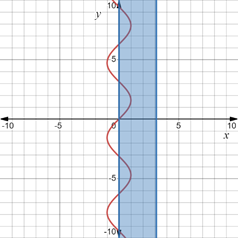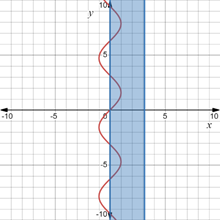
(a)
To set: An integral for the length of the curve
(a)
Answer to Problem 4E
The length of the curve is
Explanation of Solution
Given information: A curve is given as
Formula used: The arc length of curve is given by
Calculation:
The given curve
so using the formula for arc length of curve one gets as:
Hence the length of the curve is
(b)
To graph: The graph of the given curve needs to be determined.
(b)
Answer to Problem 4E
The graph of given curve is plotted below using Desmos graphing calculator.

Explanation of Solution
Given information: A curve is given as
Calculation: The graph is plotted below:

(c)
To find: The length of the curve needs to be determined using NINT.
(c)
Answer to Problem 4E
The length of the curve using NINT is
Explanation of Solution
Given information: A curve is given as
Calculation: The length of the curve is found using NINT with the help of calculator as
Hence the answer is
Chapter 7 Solutions
Advanced Placement Calculus Graphical Numerical Algebraic Sixth Edition High School Binding Copyright 2020
- Find the equation of the tangent line to the graph of the given function at the given value of x. 6 f(x) = x(x² - 4x+5)*; x=2arrow_forwardFind the equation of the tangent line to the graph of the given function at the given value of x. f(x)=√√x+33; x=4arrow_forwardFind g[f(-7)]. f(x) = x² + 1; g(x)=-5x-1arrow_forward
 Calculus: Early TranscendentalsCalculusISBN:9781285741550Author:James StewartPublisher:Cengage Learning
Calculus: Early TranscendentalsCalculusISBN:9781285741550Author:James StewartPublisher:Cengage Learning Thomas' Calculus (14th Edition)CalculusISBN:9780134438986Author:Joel R. Hass, Christopher E. Heil, Maurice D. WeirPublisher:PEARSON
Thomas' Calculus (14th Edition)CalculusISBN:9780134438986Author:Joel R. Hass, Christopher E. Heil, Maurice D. WeirPublisher:PEARSON Calculus: Early Transcendentals (3rd Edition)CalculusISBN:9780134763644Author:William L. Briggs, Lyle Cochran, Bernard Gillett, Eric SchulzPublisher:PEARSON
Calculus: Early Transcendentals (3rd Edition)CalculusISBN:9780134763644Author:William L. Briggs, Lyle Cochran, Bernard Gillett, Eric SchulzPublisher:PEARSON Calculus: Early TranscendentalsCalculusISBN:9781319050740Author:Jon Rogawski, Colin Adams, Robert FranzosaPublisher:W. H. Freeman
Calculus: Early TranscendentalsCalculusISBN:9781319050740Author:Jon Rogawski, Colin Adams, Robert FranzosaPublisher:W. H. Freeman
 Calculus: Early Transcendental FunctionsCalculusISBN:9781337552516Author:Ron Larson, Bruce H. EdwardsPublisher:Cengage Learning
Calculus: Early Transcendental FunctionsCalculusISBN:9781337552516Author:Ron Larson, Bruce H. EdwardsPublisher:Cengage Learning





